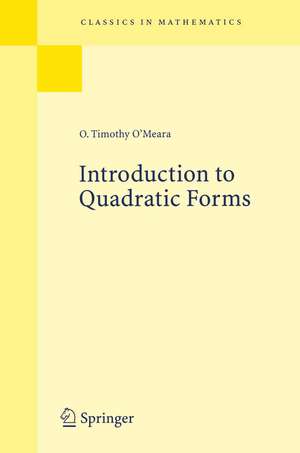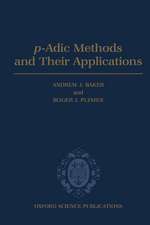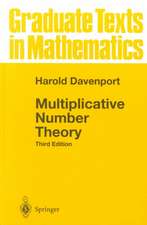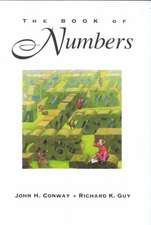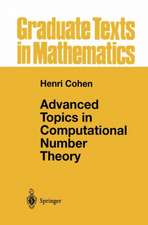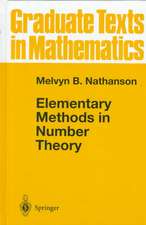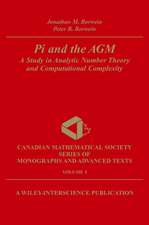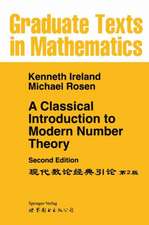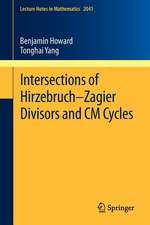Introduction to Quadratic Forms: Classics in Mathematics
Autor O. Timothy O'Mearaen Limba Engleză Paperback – 13 dec 1999
Din seria Classics in Mathematics
-
 Preț: 404.18 lei
Preț: 404.18 lei -
 Preț: 428.05 lei
Preț: 428.05 lei -
 Preț: 400.47 lei
Preț: 400.47 lei -
 Preț: 404.34 lei
Preț: 404.34 lei -
 Preț: 402.27 lei
Preț: 402.27 lei -
 Preț: 422.11 lei
Preț: 422.11 lei -
 Preț: 438.87 lei
Preț: 438.87 lei -
 Preț: 431.56 lei
Preț: 431.56 lei -
 Preț: 425.80 lei
Preț: 425.80 lei -
 Preț: 429.61 lei
Preț: 429.61 lei -
 Preț: 421.72 lei
Preț: 421.72 lei -
 Preț: 425.80 lei
Preț: 425.80 lei -
 Preț: 427.49 lei
Preț: 427.49 lei -
 Preț: 421.17 lei
Preț: 421.17 lei -
 Preț: 415.39 lei
Preț: 415.39 lei -
 Preț: 485.07 lei
Preț: 485.07 lei -
 Preț: 437.72 lei
Preț: 437.72 lei -
 Preț: 444.47 lei
Preț: 444.47 lei -
 Preț: 440.39 lei
Preț: 440.39 lei -
 Preț: 447.73 lei
Preț: 447.73 lei -
 Preț: 438.10 lei
Preț: 438.10 lei -
 Preț: 509.50 lei
Preț: 509.50 lei -
 Preț: 418.83 lei
Preț: 418.83 lei -
 Preț: 436.74 lei
Preț: 436.74 lei -
 Preț: 446.37 lei
Preț: 446.37 lei -
 Preț: 430.59 lei
Preț: 430.59 lei -
 Preț: 421.93 lei
Preț: 421.93 lei -
 Preț: 429.06 lei
Preț: 429.06 lei -
 Preț: 431.56 lei
Preț: 431.56 lei -
 Preț: 457.36 lei
Preț: 457.36 lei -
 Preț: 429.99 lei
Preț: 429.99 lei -
 Preț: 504.66 lei
Preț: 504.66 lei -
 Preț: 433.31 lei
Preț: 433.31 lei -
 Preț: 418.07 lei
Preț: 418.07 lei -
 Preț: 428.07 lei
Preț: 428.07 lei -
 Preț: 427.33 lei
Preț: 427.33 lei -
 Preț: 437.50 lei
Preț: 437.50 lei -
 Preț: 425.80 lei
Preț: 425.80 lei -
 Preț: 438.26 lei
Preț: 438.26 lei -
 Preț: 408.61 lei
Preț: 408.61 lei -
 Preț: 432.51 lei
Preț: 432.51 lei -
 Preț: 429.61 lei
Preț: 429.61 lei -
 Preț: 435.20 lei
Preț: 435.20 lei -
 Preț: 428.68 lei
Preț: 428.68 lei -
 Preț: 437.12 lei
Preț: 437.12 lei -
 Preț: 438.69 lei
Preț: 438.69 lei
Preț: 422.90 lei
Nou
Puncte Express: 634
Preț estimativ în valută:
80.92€ • 84.72$ • 66.96£
80.92€ • 84.72$ • 66.96£
Carte tipărită la comandă
Livrare economică 05-19 aprilie
Preluare comenzi: 021 569.72.76
Specificații
ISBN-13: 9783540665649
ISBN-10: 3540665641
Pagini: 360
Ilustrații: XIV, 344 p. 1 illus.
Dimensiuni: 155 x 235 x 19 mm
Greutate: 0.45 kg
Ediția:2000
Editura: Springer Berlin, Heidelberg
Colecția Springer
Seria Classics in Mathematics
Locul publicării:Berlin, Heidelberg, Germany
ISBN-10: 3540665641
Pagini: 360
Ilustrații: XIV, 344 p. 1 illus.
Dimensiuni: 155 x 235 x 19 mm
Greutate: 0.45 kg
Ediția:2000
Editura: Springer Berlin, Heidelberg
Colecția Springer
Seria Classics in Mathematics
Locul publicării:Berlin, Heidelberg, Germany
Public țintă
ResearchDescriere
From the reviews: "O'Meara treats his subject from this point of view (of the interaction with algebraic groups). He does not attempt an encyclopedic coverage ...nor does he strive to take the reader to the frontiers of knowledge... . Instead he has given a clear account from first principles and his book is a useful introduction to the modern viewpoint and literature. In fact it presupposes only undergraduate algebra (up to Galois theory inclusive)... The book is lucidly written and can be warmly recommended.
J.W.S. Cassels, The Mathematical Gazette, 1965
"Anyone who has heard O'Meara lecture will recognize in every page of this book the crispness and lucidity of the author's style;... The organization and selection of material is superb... deserves high praise as an excellent example of that too-rare type of mathematical exposition combining conciseness with clarity...
R. Jacobowitz, Bulletin of the AMS, 1965
J.W.S. Cassels, The Mathematical Gazette, 1965
"Anyone who has heard O'Meara lecture will recognize in every page of this book the crispness and lucidity of the author's style;... The organization and selection of material is superb... deserves high praise as an excellent example of that too-rare type of mathematical exposition combining conciseness with clarity...
R. Jacobowitz, Bulletin of the AMS, 1965
Cuprins
Prerequisites ad Notation Part One: Arithmetic Theory of Fields I Valuated Fields Valuations Archimedean ValuationsNon-Archimedean valuations Prolongation of a complete valuation to a finite extensionProlongation of any valuation to a finite separable extension Discrete valuations II Dedekind Theory of Ideals Dedekind axioms for S Ideal theory Extension fields III Fields of Number TheoryRational global fieldsLocal fieldsGlobal fieldsPart Two: Abstract Theory of Quadratic FormsVI Quadratic Forms and the Orthogonal GroupForms, matrices and spacesQuadratic spacesSpecial subgroups of On(V)V The Algebras of Quadratic FormsTensor productsWedderburn's theorem on central simple algebrasExtending the field of scalarsThe clifford algebraThe spinor normSpecial subgroups of On(V)Quaternion algebrasThe Hasse algebraVI The Equivalence of Quadratic FormsComplete archimedean fieldsFinite fieldsLocal fieldsGlobal notationSquares and norms in global fieldsQuadratic forms over global fieldsVII Hilbert's Reciprocity LawProof of the reciprocity lawExistence of forms with prescribed local behaviorThe quadratic reciprocity lawPart Four: Arithmetic Theory of Quadratic Forms over RingsVIII Quadratic Forms over Dedekind DomainsAbstract latticesLattices in quadratic spacesIX Integral Theory of Quadratic Forms over Local FieldsGeneralities Classification of lattices over non-dyadic fieldsClassification of Lattices over dyadic fieldsEffective determination of the invariantsSpecial subgroups of On(V)X Integral Theory of Quadratic Forms over Global FieldsElementary properties of the orthogonal group over arithmetic fieldsThe genus and the spinor genusFiniteness of class numberThe class and the spinor genus in the indefinite caseThe indecomposable splitting of a definite latticeDefinite unimodular lattices over the rational integersBibliographyIndex BibliographyIndex
Recenzii
"The exposition follows the tradition of the lectures of Emil Artin who enjoyed developing a subject from first principles and devoted much research to finding the simplest proofs at every stage." - American Mathematical Monthly
Notă biografică
Biography of O. Timothy O'Meara
Timothy O'Meara was born on January 29, 1928. He was educated at the University of Cape Town and completed his doctoral work under Emil Artin at Princeton University in 1953. He has served on the faculties of the University of Otago, Princeton University and the University of Notre Dame. From 1978 to 1996 he was provost of the University of Notre Dame. In 1991 he was elected Fellow of the American Academy of Arts and Sciences.
O'Mearas first research interests concerned the arithmetic theory of quadratic forms. Some of his earlier work - on the integral classification of quadratic forms over local fields - was incorporated into a chapter of this, his first book.
Later research focused on the general problem of determining the isomorphisms between classical groups. In 1968 he developed a new foundation for the isomorphism theory which in the course of the next decade was used by him and others to capture all the isomorphisms among large new families of classical groups. In particular, this program advanced the isomorphism question from the classical groups over fields to the classical groups and their congruence subgroups over integral domains.
In 1975 and 1980 O'Meara returned to the arithmetic theory of quadratic forms, specifically to questions on the existence of decomposable and indecomposable quadratic forms over arithmetic domains.
Timothy O'Meara was born on January 29, 1928. He was educated at the University of Cape Town and completed his doctoral work under Emil Artin at Princeton University in 1953. He has served on the faculties of the University of Otago, Princeton University and the University of Notre Dame. From 1978 to 1996 he was provost of the University of Notre Dame. In 1991 he was elected Fellow of the American Academy of Arts and Sciences.
O'Mearas first research interests concerned the arithmetic theory of quadratic forms. Some of his earlier work - on the integral classification of quadratic forms over local fields - was incorporated into a chapter of this, his first book.
Later research focused on the general problem of determining the isomorphisms between classical groups. In 1968 he developed a new foundation for the isomorphism theory which in the course of the next decade was used by him and others to capture all the isomorphisms among large new families of classical groups. In particular, this program advanced the isomorphism question from the classical groups over fields to the classical groups and their congruence subgroups over integral domains.
In 1975 and 1980 O'Meara returned to the arithmetic theory of quadratic forms, specifically to questions on the existence of decomposable and indecomposable quadratic forms over arithmetic domains.
Textul de pe ultima copertă
Timothy O'Meara was born on January 29, 1928. He was educated at the University of Cape Town and completed his doctoral work under Emil Artin at Princeton University in 1953. He has served on the faculties of the University of Otago, Princeton University and the University of Notre Dame. From 1978 to 1996 he was provost of the University of Notre Dame. In 1991 he was elected Fellow of the American Academy of Arts and Sciences. O'Mearas first research interests concerned the arithmetic theory of quadratic forms. Some of his earlier work - on the integral classification of quadratic forms over local fields - was incorporated into a chapter of this, his first book. Later research focused on the general problem of determining the isomorphisms between classical groups. In 1968 he developed a new foundation for the isomorphism theory which in the course of the next decade was used by him and others to capture all the isomorphisms among large new families of classical groups. In particular, this program advanced the isomorphism question from the classical groups over fields to the classical groups and their congruence subgroups over integral domains. In 1975 and 1980 O'Meara returned to the arithmetic theory of quadratic forms, specifically to questions on the existence of decomposable and indecomposable quadratic forms over arithmetic domains.
